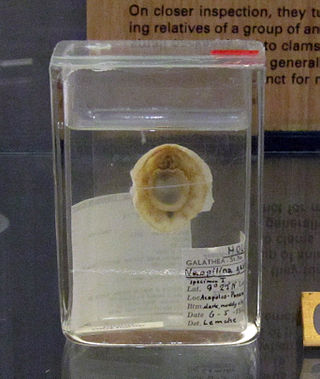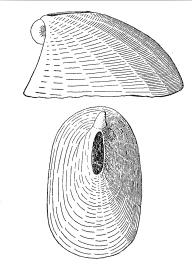| Maikhanellidae Temporal range: | |
|---|---|
| Scientific classification | |
| Kingdom: | Animalia |
| Phylum: | Mollusca |
| Class: | Monoplacophora |
| Family: | † Maikhanellidae |
The Maikhanellidae are a family of Early Cambrian monoplacophora with a limpet-like morphology. [1]
| Maikhanellidae Temporal range: | |
|---|---|
| Scientific classification | |
| Kingdom: | Animalia |
| Phylum: | Mollusca |
| Class: | Monoplacophora |
| Family: | † Maikhanellidae |
The Maikhanellidae are a family of Early Cambrian monoplacophora with a limpet-like morphology. [1]

Monoplacophora, meaning "bearing one plate", is a polyphyletic superclass of molluscs with a cap-like shell inhabiting deep sea environments. Extant representatives were not recognized as such until 1952; previously they were known only from the fossil record, and were thought to have become extinct 375 million years ago.
Helcionellid or Helcionelliformes is an order of small fossil shells that are universally interpreted as molluscs, though no sources spell out why this taxonomic interpretation is preferred. These animals are first found about 540 to 530 million years ago in the late Nemakit-Daldynian age, which is the earliest part of the Cambrian period. A single species persisted to the Early Ordovician. These fossils are component of the small shelly fossils (SSF) assemblages.
Micropilina is a genus of monoplacophoran molluscs. They are very small, mostly deepwater animals which have a superficially limpet-like shell.
Aldanellidae is an extinct family of paleozoic molluscs that have been assigned to the Gastropod stem group but may also belong to a paraphyletic "Monoplacophora".
Stenothecidae is an extinct family of fossil univalved Cambrian molluscs which may be either gastropods or monoplacophorans.
Yochelcionelloidea is an extinct superfamily of paleozoic molluscs of uncertain position. The earliest yochelcionellids are known from the Middle Tommotian, but they are most diverse from the Botomian through the early Middle Cambrian.
The Kirengellids are a group of problematic Cambrian fossil shells of marine organisms. The shells bear a number of paired muscle scars on the inner surface of the valve.
Pyropelta corymba is a species of small sea snail, a deep-water limpet, a marine gastropod mollusk in the family Pyropeltidae
Pyropelta musaica is a species of small sea snail, a deep-water limpet, a marine gastropod mollusks in the family Pyropeltidae.

Paralepetopsis lepichoni is a species of sea snail, a true limpet, a marine gastropod mollusk in the family Neolepetopsidae, one of the families of true limpets. It is part of the subclass of Gastropoda called Vetigastropoda.
Lepetodrilus elevatus is a species of small, deep-sea sea snail, a hydrothermal vent limpet, a marine gastropod mollusk in the family Lepetodrilidae.

Lepetodrilus ovalis is a species of small, deep-sea sea snail, a hydrothermal vent limpet, a marine gastropod mollusk in the family Lepetodrilidae.
The cephalopods have a long geological history, with the first nautiloids found in late Cambrian strata, and purported stem-group representatives present in the earliest Cambrian lagerstätten.
Aldanella is an extinct paleozoic mollusc that was assigned to the Gastropod stem group but may also belong to a paraphyletic "Monoplacophora".
Shelbyoceras is a genus of Cambrian monoplacophora which was one of the genera mistaken for a cephalopod, since the characteristics differentiating monoplacophora from cephalopods are few. Shelbyoceras was reclassified based on a depressed groove that forms a band around the shell, which is similar to a feature seen in Hypseloconus. The septa in this genus are either closely or irregularly spaced.
The oesophageal pouches are a pair of pouches connected to the oesophagus of all molluscs, and represent a synapomorphy of the phylum.
Tannuella is a genus of helcionellids known from Lower Cambrian strata.

Vacerrena kesteveni is a species of sea snail, a marine gastropod mollusk in the family Fissurellidae, the keyhole limpets and slit limpets.
Veleropilina veleronis is a species of monoplacophoran, a superficially limpet-like marine mollusc. It is found off Cedros Island, Mexico in the Pacific Ocean.
Micropilina minuta is a species of monoplacophoran, a superficially limpet-like marine mollusc. It has been found off the coasts of Iceland and Italy.